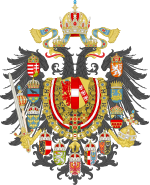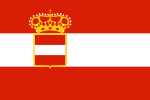
Back Avstriya-Macarıstan Silahlı Qüvvələri Azerbaijani Узброеныя сілы Аўстра-Венгрыі Byelorussian Ozbrojené síly Rakousko-Uherska Czech Streitkräfte von Österreich-Ungarn German Forces armées austro-hongroises French Oružane snage Austro-Ugarske Croatian Császári és Királyi Fegyveres Erők Hungarian Forze armate dell'Impero austro-ungarico Italian 오스트리아-헝가리군 Korean Angkatan Tentera Austria-Hungary Malay
This article has multiple issues. Please help improve it or discuss these issues on the talk page. (Learn how and when to remove these template messages)
|
| Austro-Hungarian Armed Forces | |
|---|---|
| Bewaffnete Macht | |
 Standard of the Supreme Commander in Chief, the Emperor of Austria, King of Hungary | |
| Founded | 5 March 1867 |
| Disbanded | 3 December 1918 |
| Service branches | |
| Headquarters | Vienna |
| Leadership | |
| Supreme Commander | Hermann Kövess von Kövessháza (last) |
| Minister of War | Rudolf Stöger-Steiner von Steinstätten (last) |
| Chief of the General Staff | Arthur Arz von Straußenburg (last) |
| Personnel | |
| Military age | 17 years of age |
| Available for military service | 13,402,788, age 15–49 (1914 est.) |
| Fit for military service | 9,031,046, age 15–49 (1914 est.) |
| Reaching military age annually | 423,809 (1914 est.) |
| Active personnel | 2,500,000 (1914) |
| Deployed personnel | 7,800,000 (1914–1918) |
| Industry | |
| Domestic suppliers | |
| Related articles | |
| History | Austrian Empire Austrian Army Military history of Austria Imperial and Royal Army during the Napoleonic Wars |
| Ranks | Army ranks Navy ranks |





The Austro-Hungarian Armed Forces (German: Bewaffnete Macht or Wehrmacht; Hungarian: Fegyveres Erő) or Imperial and Royal Armed Forces were the military forces of Austria-Hungary. It comprised two main branches: The Army (Landstreitkräfte) and the Navy (Kriegsmarine). Both of them organised their own aviation branches – the Army's Aviation Troops (K.u.K. Luftfahrtruppen) and the Navy's Naval Aviation (K.u.K. Seefliegerkorps). The Army in turn consisted of its own three branches: The Common Army (Gemeinsame Armee), the Imperial-Royal Landwehr (kaiserlich-königliche Landwehr) and the Royal Hungarian Honvéd (königlich ungarische Landwehr).
Supreme Commander of the Armed Forces was the Emperor-King, the professional leader was the Chief of the General Staff and the head of the joint Ministry for military affairs was the Minister of War.
The Armed Forces served as one of the Empire's core unifying institutions and the principal instrument for the national defense as well as external power projection. The history of the Austro-Hungarian military begins when the Habsburgs established hereditary rule over Austrian lands in the 13th century and stretches until the fall of the Habsburgs, at the end of World War I, during which time their armies were among the largest and most significant in Europe. Though not as powerful as some of its contemporaries, the military of Austria-Hungary's scale, resources, organization, technology and training were one of the central factors determining conferral of 'great power' status on the empire for much of the 19th and early 20th centuries.
© MMXXIII Rich X Search. We shall prevail. All rights reserved. Rich X Search